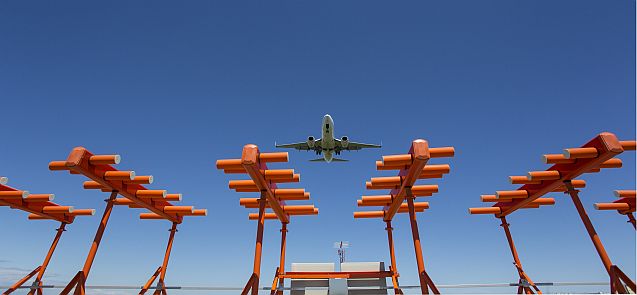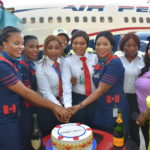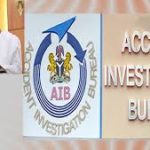
Despite the current efforts to improve navigational aids and safety in Nigeria’s airspace, flights are still disrupted by avoidable low visibility and pilots complain about poor communication at certain areas of the airspace.
Recently Captain Constant BihinaKono landed his aircraft, a Boeing B737 NG at the Murtala Muhammed International Airport (MMIA), Lagos to mark the inaugural flight of the Cameroon national airline, Camair-Co to Nigeria.
When Captain Kono was asked about his experience, he said it was good, besides the turbulence that was caused by unfavourable weather. Then, he added that entering into Nigeria’s airspace was like entering European airspace because it has radar, which aids navigation.
He added that he had not flown in radar airspace for a long time.
“We have not been flying into radar for a long time. Nigeria is so advanced when it comes to aviation that flying in the Nigeria airspace is like you are flying in Europe.
“So, we are happy to be back to Nigeria and besides the weather, our flight was safe and flying to Nigeria to the happiness of our passengers is the best source of satisfaction for me,” Captain Kono said.
What Kono’s statement meant was that all the time he has been flying around Africa, especially West and Central Africa he has not been flying into radar until his flight to Nigeria. Since the last eight years the Total Radar Coverage of Nigeria (TRACON) has provided effective radar service to flights into Nigeria, which obviously has improved the airspace.
Challenges
But despite this improvement, there are still issues with navigational aids. Pilots who spoke to THISDAY said instrument landing system is still problematic in some airports; that either they are not functional, or they are obsolete and epileptic.
Airlines however said the major problem they face every year is the harmattan haze, which disrupts their flight at the peak December/January season.
The airlines said with airfield lighting at most of the airports and effective navigational aids in the airspace, Nigerian airlines could operate their aircraft for longer hours.
Such long hours would generate more revenue and improve the health of their aircraft, which need to be operated for a certain number of hours per day.
Funding
The Chief Operating Officer of Dana Air, Obi Mbanuzuo said the federal government should regard funding of navigational aids as priority because of the critical role played by air transport as catalyst to the economy.
He said the Nigerian Airspace Management Agency (NAMA) should be given the financial support its needs for critical infrastructure to improve navigation in the airspace.
“We are looking at two things. One thing we keep saying is that we all have to understand the contribution aviation makes to the economy.
“Aviation is not simply that people are flying up and down, no. If all the airlines in Nigeria shutdown for one day, we know that a percentage of the GDP will be lost because some work that was supposed to have been done will not be done.
“Some goods supposed to have been moved from, maybe one point to another for production will not make it. People that would have gone somewhere to make money will not. After all, what is GDP? It is work.
“So, aviation contributes a lot to the GDP of Nigeria,” Mbanuzuo said.
He noted that every year harmattan comes, flights are cancelled, and “money is lost. Money is not lost by the airlines; money is lost by the economy, by the country. Money is lost by people not being able to go to places they wish to go, so why then haven’t we been able to put in place navigational aids, landing aids that can allow us to fly in harmattan?”

Tougher Weather Conditions
Mbanuzuo said what is ironical about the problem of harmattan haze is that with the right equipment flights can go on during the haze and noted that under worse conditions in Europe and other parts of the world aircraft still fly.
“People will fly around the world in worse conditions than harmattan, in zero, zero visibility conditions but in harmattan you will even see a little bit.
“But we don’t put those things (equipment) in place, all our aeroplanes, even the aeroplane that Dana Air is currently saying we want to renew, can land itself with the right landing aid.
“Put the correct landing aid on the ground and calibrate them and make sure they are working correctly and the airplanes will fly. Then change the minima (lowest accepted weather condition for flights) in the regulation because it is linked; the regulation currently says you do 1,200 meters visibility. Well with 400 meters visibility and a Category 2 instrument landing aid, the aircraft will land and take-off.
“But now if I have 400 metres visibility, even in harmattan, I can see up there even with 400 metres and can even fly, but the regulation says I must have 1,200 meters visibility.
“So once the landing aids are put in place and the regulator checks and established that they are working; then he will change the regulation to allow us to fly, then harmattan becomes a thing of the past,” the DANA COO said.
Weather Minima
However, the Nigerian Civil Aviation Authority (NCAA) in conjunction with the Nigerian Airspace Management Agency (NAMA) in January this year lowered minimum visibility for take-off and landing of flights for 18 airports which have improved navigational aids, including Performance Based Navigation (PBN) and other equipment that enhance visibility during inclement weather.
Before now, the average minimum visibility was 800 metres below which flights were not allowed to operate to the airports, but now flights can operate when visibility is about 150 meters, depending on the available navigational aids.
The implication of this is that flights that were hitherto stopped from operating to airports when the visibility were below 800 metres can now operate; so even at the height of harmattan haze last December, airlines would have operated with the minimum visibility.
NCAA said the review was in compliance with the provision of Part 8 of the Nigerian Civil Aviation Regulations (Nig.CARs Part 8), and in accordance with International Civil Aviation Organisation (ICAO) Doc.9365.
“In this review, the Regulatory Authority took cognisance of improvements in visual and navigational aids within the affected airports. The reviewed Aerodrome Operating Minima would serve to enhance the operating capacity of the aerodromes.
“This is due to the fact that it will avail the operators with improved minima for low visibility operations,” the regulatory authority said.
According to the review, the landing minima specified for all the 18 airports were determined based on applicable criteria as defined in the International Civil Aviation Organisation (ICAO) regulations and these includes all relevant amendments, as well as available navigational facilities, including Instrument Landing System, Voice Omni directional Radio Range and Distance Measuring Equipment (ILS,VOR/DME, etc) or PBN Navigational Specification (RNAV/GNSS).

“On the other hand, the reviewed operating minima provided for aperformance-based take-off minima for the affected aerodromes in Nigeria is determined by available visual aids for take-off.
“These are Runway Centre Lights, Touchdown Zone lights, Runway Edge Lights, Threshold Lights, Runway End Lights and Runway Surface Markings.
The 18 aerodromes where the operating minima and take-off minima have been reviewed are Lagos, Abuja, Kano, Port Harcourt, Calabar, Dutse, Eket and Enugu. Others are Gombe, Ilorin, Kaduna, Katsina, Kebbi, Owerri, Sokoto, Uyo, Yola and Zaria,” NCAA explained.
Availability of Critical Equipment
Industry observers had noted that some of the necessary equipment mentioned above might not be available in some of these airports with lowered weather minima.
They remarked that it is not only navigational aids that are lacking but also airfield lighting which is major hindrance in many airports. Airfield lighting is critical for airports, especially if the flight is operating after 6:00 pm.
Airfield lighting installation is under the management of the Federal Airports Authority of Nigeria (FAAN).
Pilots who spoke to THISDAY agreed that with the lowering of the weather minima there would be less cancellation and delay of flights destined to the aforementioned airports. This means that in 2018 and afterwards fewer flights would be cancelled or delayed during the Yuletide; but if all the necessary navigational aids and airfield lighting are installed at these airports, there would be no flight cancellation or delay during the period, except during extremely inclement weather.
However, the Managing Director of NAMA, Captain FolaAkinkuotu said there has been a lot of improvement in the airspace since the last three years.
He said that a lot of critical navigational equipment had been ordered, some have been installed and others have been imported to be installed.
In addition, he said if funding is made available before December this year, Nigeria’s two busiest airports in Lagos and Abuja would have Category 3 Instrument Landing System (ILS), which would enable flights to operate at the height of harmattan.
“The Federal Executive Council (FEC) has given us approval for the procurement and installation of Cat 3 ILS at Abuja and Lagos airports.
“We have already signed the deal with the contractor so we are waiting for funds. We are also working to install ILS at the Benin airport. This is a federal government project but we are collaborating with Edo state government.
“We have already installed new ILS at the airports in Lagos, Kano, Maiduguri and also installed Voice Ominidirectional Radio Range (VOR) and ILS in Minna, Niger state.
“In communication, we are looking at providing holistic solution and we have secured FEC approval to expand coverage to cover all over the nation’s airspace.
“We are also extending our surveillance to the Gulf of Guinea through the multilateral project, which would cover low flying aircraft in the Niger Delta. This has received FEC approval also and the contract has been signed. We have also done radio sectorisation in Lagos for area communication,” Akinkuotu said.
An operator of one of the domestic airlines recently intoned that despite all the talk, “we still have problems in the airspace” but admitted that it is a lot better than it is used to be. NAMA said that it is geared to provide all inclusive improvement of Nigeria’s airspace: communication, navigation and surveillance (CNS).
THISDAY






